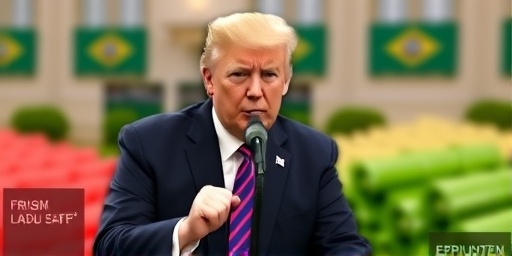In a significant shift in U.S. trade policy, President Donald Trump announced the immediate removal of a 40% tariff on select Brazilian agricultural products, marking a breakthrough in ongoing negotiations between the two nations. This decision, revealed during a White House press briefing on Wednesday, comes after months of diplomatic efforts aimed at resolving longstanding trade disputes. The move is poised to reduce costs for American consumers on essential imports like soybeans and coffee, while signaling a thaw in relations strained by previous protectionist measures.
- Breakthrough in U.S.-Brazil Trade Talks Spurs Tariff Elimination
- American Consumers to Benefit from Lower Prices on Everyday Imports
- Agricultural Sectors Poised for Growth in Bilateral Trade
- Geopolitical Ramifications: Easing Tensions in U.S.-Brazil Relations
- Outlook: Next Steps in Strengthening U.S.-Brazil Trade Ties
Breakthrough in U.S.-Brazil Trade Talks Spurs Tariff Elimination
The announcement follows intensive trade discussions that began in early 2023, where U.S. and Brazilian officials addressed imbalances in agricultural exports. Under the previous administration’s policies, tariffs on Brazilian goods were imposed to protect domestic farmers, but these measures had inadvertently driven up prices for U.S. importers and consumers. President Trump, speaking to reporters, emphasized the reciprocal benefits: “We’ve made great progress with Brazil on fair trade. Removing these tariffs opens doors for American businesses while ensuring our farmers get a level playing field.”
According to a statement from the U.S. Trade Representative’s office, the tariffs affected approximately $2.5 billion worth of Brazilian agricultural exports annually, including key commodities such as orange juice, sugar, and ethanol. The 40% levy, enacted in 2018 as part of broader retaliatory actions during the U.S.-China trade war spillover, had been a point of contention. Brazilian President Luiz Inácio Lula da Silva hailed the decision as a “victory for bilateral cooperation,” noting in a televised address that it would boost Brazil’s economy by an estimated 1.2% in agricultural GDP growth over the next year.
Trade experts attribute the breakthrough to a series of virtual summits held between February and June 2024. During these talks, both sides agreed to mutual concessions, including Brazil’s commitment to increase purchases of U.S. aircraft and machinery. “This isn’t just about tariffs; it’s about building a sustainable trade framework,” said Dr. Elena Ramirez, a senior fellow at the Brookings Institution specializing in Latin American economics. Ramirez pointed out that the U.S. imported over $4 billion in Brazilian agricultural products in 2023, making Brazil the second-largest supplier after Canada.
American Consumers to Benefit from Lower Prices on Everyday Imports
The tariff removal is expected to have a direct and positive impact on U.S. grocery bills, particularly for items heavily reliant on Brazilian sourcing. For instance, Brazil supplies about 80% of the orange juice consumed in the United States, and the 40% tariff had added roughly 15-20 cents per gallon to retail prices, according to data from the U.S. Department of Agriculture (USDA). With the tariffs lifted, industry analysts predict a 10-15% price drop within the next six months, providing relief amid persistent inflation concerns.
Beyond orange juice, the policy change affects a range of products vital to the American diet. Soybeans from Brazil, used in everything from animal feed to processed foods, will see reduced costs that could lower meat prices by up to 5%, per a report from the American Farm Bureau Federation. Coffee importers, who source nearly 30% of U.S. beans from Brazil, anticipate savings of $500 million annually, which could translate to cheaper lattes and blends at chains like Starbucks and Dunkin’.
Consumer advocacy groups have welcomed the news. “This is a win for families struggling with food costs,” stated Mark Levin, president of the Consumer Federation of America, in an interview with CNN. “Tariffs like these act as a hidden tax, and removing them aligns with President Trump‘s promise to prioritize American wallets over outdated trade barriers.” However, some economists caution that short-term fluctuations in global commodity prices could temper these benefits, especially if Brazil faces domestic weather challenges affecting harvests.
- Key Products Impacted: Orange juice, soybeans, coffee, sugar, ethanol.
- Estimated Savings: $1-2 billion for U.S. importers in the first year.
- Consumer Price Effect: Potential 5-15% reduction on affected goods.
To illustrate the broader economic ripple, consider the supply chain: Lower input costs for food manufacturers could enhance competitiveness against European and Asian rivals, potentially stabilizing jobs in processing sectors across states like Florida and California, major hubs for Brazilian imports.
Agricultural Sectors Poised for Growth in Bilateral Trade
For the agricultural industries on both sides of the Atlantic, the tariff lift represents a pivotal moment. In Brazil, the National Confederation of Agriculture (CNA) estimates that exports to the U.S. could surge by 25% in 2025, benefiting over 1.5 million farmers in regions like São Paulo and Mato Grosso. These areas, known as Brazil’s agricultural heartland, produce vast quantities of soybeans—over 150 million metric tons annually—much of which heads to American markets for biofuel and livestock feed.
In the U.S., the decision alleviates pressures on domestic agriculture, which has been grappling with retaliatory tariffs from Brazil imposed in 2019. Those countermeasures targeted U.S. exports like wheat and pork, costing American farmers an estimated $300 million. Now, with tensions easing, USDA projections show potential for increased U.S. agricultural sales to Brazil, possibly reaching $3 billion by 2026. “This reciprocal action strengthens our ag trade position,” noted Agriculture Secretary Tom Vilsack in a USDA press release, highlighting opportunities for corn and dairy exports.
Environmental considerations are also in play. Brazil has pledged to enhance sustainable farming practices in exchange for tariff relief, including reduced deforestation in the Amazon linked to soy expansion. A joint U.S.-Brazil task force, announced alongside the tariff news, will monitor compliance, aiming to align trade growth with climate goals. Critics from environmental groups like Greenpeace argue that more robust oversight is needed, but proponents see it as a model for green trade agreements.
- Brazilian Gains: Boost in soy and coffee exports, supporting rural economies.
- U.S. Advantages: Cheaper imports and expanded export markets for grains and meats.
- Sustainability Focus: Commitments to eco-friendly agriculture amid global scrutiny.
Stakeholders in the sector, including the Brazilian Agribusiness Association, are already planning investments in logistics to capitalize on the open market. Meanwhile, U.S. ports in the Gulf Coast, such as those in Louisiana, are preparing for increased vessel traffic from Brazilian exporters.
Geopolitical Ramifications: Easing Tensions in U.S.-Brazil Relations
The tariff removal extends beyond economics, serving as a diplomatic olive branch at a time when U.S.-Latin American ties are under review. Relations between Trump and Lula have been frosty, marked by differences over issues like democracy in Venezuela and trade equity. This policy shift, however, underscores a pragmatic approach to fostering stability in the Western Hemisphere. “It’s a smart move to counterbalance China’s growing influence in South America,” observed foreign policy analyst Carlos Fuentes in a Foreign Affairs op-ed published Thursday.
China, Brazil’s largest trading partner, has been aggressively buying up South American agricultural output, with soybean imports alone valued at $40 billion in 2023. By easing tariffs, the U.S. aims to reclaim market share and diversify supply chains away from over-reliance on Asian sources—a strategy amplified since the COVID-19 disruptions. Brazilian officials, in turn, view the agreement as a hedge against U.S.-China rivalry, allowing Brasília to play both powers off each other for better deals.
Quotes from key figures paint a picture of optimism. Trump tweeted post-announcement: “Great deal with Brazil—tariffs gone, trade flowing, America winning bigly!” Lula responded via Instagram: “This partnership will feed millions and build bridges, not walls.” Yet, not all voices are unanimous; some U.S. congressional Republicans, protective of Midwestern farm states, expressed concerns that the move could undercut local producers without sufficient safeguards.
Broader context includes the U.S.-Mexico-Canada Agreement (USMCA), which has set precedents for tariff-free agricultural trade. Experts suggest this Brazil deal could pave the way for similar pacts with other Latin nations, potentially forming a hemispheric trade bloc. Data from the World Trade Organization indicates that agricultural tariffs remain a flashpoint globally, with average rates hovering at 15%—making this 40% cut particularly noteworthy.
Outlook: Next Steps in Strengthening U.S.-Brazil Trade Ties
Looking ahead, the tariff elimination sets the stage for deeper integration. Negotiators from both countries plan to convene in Washington D.C. next month to draft a comprehensive free trade memorandum, potentially covering intellectual property in biotech seeds and labor standards in agribusiness. The USDA forecasts that full implementation could add $5 billion to bilateral trade volumes by 2027, with ripple effects on global food security.
Challenges remain, including potential WTO challenges from other exporters like Argentina, which competes directly with Brazil in soy markets. Additionally, U.S. lawmakers may push for phase-in periods to protect domestic sectors. Nonetheless, the momentum is positive. As one trade lobbyist put it, “This is the reset button we’ve needed—Trump’s tariffs era is evolving into a era of strategic partnerships.”
For consumers and businesses, the immediate horizon looks brighter with stabilized prices and expanded choices. As Brazil ramps up production and the U.S. refines its import strategies, this development could redefine agricultural trade dynamics for years to come, emphasizing collaboration over confrontation in an interconnected world.









